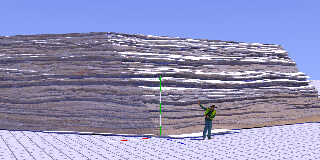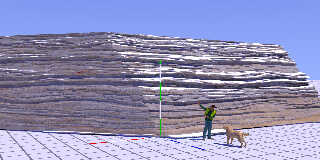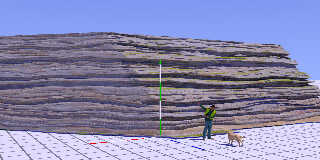 |
 |
|
 |
|
 |
|  |
|  |
|
 |
From: Thomas de Groot
Subject: Re: Heightfields of sediment layers - wip 1
Date: 5 Oct 2023 08:52:00
Message: <651eb170@news.povray.org>
|
|
 |
|  |
|  |
|
 |
A first wip...
--
Thomas
Post a reply to this message
Attachments:
Download 'hf_sedimentary_test_06.jpg' (316 KB)
Preview of image 'hf_sedimentary_test_06.jpg'

|
 |
|  |
|  |
|
 |
|
 |
|  |
|  |
|
 |
Thomas de Groot <tho### [at] degroot org> wrote:
> A first wip...
>
> --
> Thomas
Great, looking forwards to seeing this progress, I am intrigued to see what you
have planned.
Sean org> wrote:
> A first wip...
>
> --
> Thomas
Great, looking forwards to seeing this progress, I am intrigued to see what you
have planned.
Sean
Post a reply to this message
|
 |
|  |
|  |
|
 |
|
 |
|  |
|  |
|
 |
Thomas de Groot <tho### [at] degroot org> wrote:
> A first wip...
>
> --
> Thomas
It's looking promising, Thomas.
Are you using an 8-bit gray scale map? I'm not sure if you're aware of this, but
Gimp now supports 16 bits per pixel, probably even more. You might have use a
..png image if you go that route, though.
Sam org> wrote:
> A first wip...
>
> --
> Thomas
It's looking promising, Thomas.
Are you using an 8-bit gray scale map? I'm not sure if you're aware of this, but
Gimp now supports 16 bits per pixel, probably even more. You might have use a
..png image if you go that route, though.
Sam
Post a reply to this message
|
 |
|  |
|  |
|
 |
|
 |
|  |
|  |
|
 |
Il 05/10/2023 14:51, Thomas de Groot ha scritto:
> A first wip...
>
Mmm... A Great Train Robbery?
Paolo
Post a reply to this message
|
 |
|  |
|  |
|
 |
From: Thomas de Groot
Subject: Re: Heightfields of sediment layers - wip 1
Date: 6 Oct 2023 04:23:55
Message: <651fc41b@news.povray.org>
|
|
 |
|  |
|  |
|
 |
Op 5-10-2023 om 22:37 schreef Samuel B.:
> Thomas de Groot <tho### [at] degroot org> wrote:
>> A first wip...
>>
>> --
>> Thomas
>
> It's looking promising, Thomas.
>
> Are you using an 8-bit gray scale map? I'm not sure if you're aware of this, but
> Gimp now supports 16 bits per pixel, probably even more. You might have use a
> ..png image if you go that route, though.
>
Ah! Thanks for reminding me, Sam. I was (un-)aware of this in my daily
use of Gimp as 8 bits are enough for most of my purposes, but here a
higher resolution might be asked for indeed. So, I first converted my
base (layered) sediment .xcf image to 32 bits, and exported to 16 bits
.png. The difference (see attached image) is not spectacular but still
noticeable in the small details.
I need to give an explanation (with code) about what I have been doing
up till now. I shall do that over the week-end.
In any case, this project has its serious limitations indeed as it
relies entirely on provided image maps and their (limited) manipulation
within POV-Ray by different (matrix) transformations while building the
height_field(s). I shall explain later...
--
Thomas org> wrote:
>> A first wip...
>>
>> --
>> Thomas
>
> It's looking promising, Thomas.
>
> Are you using an 8-bit gray scale map? I'm not sure if you're aware of this, but
> Gimp now supports 16 bits per pixel, probably even more. You might have use a
> ..png image if you go that route, though.
>
Ah! Thanks for reminding me, Sam. I was (un-)aware of this in my daily
use of Gimp as 8 bits are enough for most of my purposes, but here a
higher resolution might be asked for indeed. So, I first converted my
base (layered) sediment .xcf image to 32 bits, and exported to 16 bits
.png. The difference (see attached image) is not spectacular but still
noticeable in the small details.
I need to give an explanation (with code) about what I have been doing
up till now. I shall do that over the week-end.
In any case, this project has its serious limitations indeed as it
relies entirely on provided image maps and their (limited) manipulation
within POV-Ray by different (matrix) transformations while building the
height_field(s). I shall explain later...
--
Thomas
Post a reply to this message
Attachments:
Download 'hf_sedimentary_test_06c.jpg' (306 KB)
Preview of image 'hf_sedimentary_test_06c.jpg'

|
 |
|  |
|  |
|
 |
From: Thomas de Groot
Subject: Re: Heightfields of sediment layers - wip 1
Date: 6 Oct 2023 08:18:13
Message: <651ffb05@news.povray.org>
|
|
 |
|  |
|  |
|
 |
Just for testing, a version with more pronounced layer boundaries...
--
Thomas
Post a reply to this message
Attachments:
Download 'hf_sedimentary_test_06e.jpg' (295 KB)
Preview of image 'hf_sedimentary_test_06e.jpg'

|
 |
|  |
|  |
|
 |
|
 |
|  |
|  |
|
 |
Op 5-10-2023 om 23:36 schreef Paolo Gibellini:
> Il 05/10/2023 14:51, Thomas de Groot ha scritto:
>> A first wip...
>>
>
> Mmm... A Great Train Robbery?
>
> Paolo
I may be dim... can you explain? :-0
--
Thomas
Post a reply to this message
|
 |
|  |
|  |
|
 |
|
 |
|  |
|  |
|
 |
Thomas de Groot <tho### [at] degroot org> wrote:
> Op 5-10-2023 om 22:37 schreef Samuel B.:
> > Thomas de Groot <tho### [at] degroot org> wrote:
> Op 5-10-2023 om 22:37 schreef Samuel B.:
> > Thomas de Groot <tho### [at] degroot org> wrote:
> >> A first wip...
> >>
> >> --
> >> Thomas
> >
> > It's looking promising, Thomas.
> >
> > [...]
> > Gimp now supports 16 bits per pixel, probably even more.
> >
> Ah! Thanks for reminding me, Sam. I was (un-)aware of this in my daily
> use of Gimp as 8 bits are enough for most of my purposes, but here a
> higher resolution might be asked for indeed. So, I first converted my
> base (layered) sediment .xcf image to 32 bits, and exported to 16 bits
> .png. The difference (see attached image) is not spectacular but still
> noticeable in the small details.
It looks a bit improved (or maybe just different), but I still see artifacts
characteristic of an 8-bit height map. The problem is that you can't add any
in-between elevations you didn't originally create... so, while the new image
might be a higher bit-depth, it will still contain the same stair-stepping
produced by the original 8-bits-per-channel image. (It might look slightly
different due to changes in the gamma level, or any up/down-scaling you might
have done, or something else, but the issue will remain.)
I can see two main options at this moment: 1) create a new height map starting
with an 16 bits per channel format, and painting everything again; or 2) convert
the map to 16 bit grayscale, upscale x2, blur slightly, and then downscale back
to the original x & y resolution using a good interpolation method. You will
lose some details with the second option. A third option might be to convert to
16-bit gray scale and then play with the blur and smudge tools, which would let
you put in some new details you might have wanted to add.
> I need to give an explanation (with code) about what I have been doing
> up till now. I shall do that over the week-end.
>
> In any case, this project has its serious limitations indeed as it
> relies entirely on provided image maps and their (limited) manipulation
> within POV-Ray by different (matrix) transformations while building the
> height_field(s). I shall explain later...
>
> --
> Thomas
I don't know exactly what your goals are, but can some things be done using
pigment maps and/or functions?
Sam org> wrote:
> >> A first wip...
> >>
> >> --
> >> Thomas
> >
> > It's looking promising, Thomas.
> >
> > [...]
> > Gimp now supports 16 bits per pixel, probably even more.
> >
> Ah! Thanks for reminding me, Sam. I was (un-)aware of this in my daily
> use of Gimp as 8 bits are enough for most of my purposes, but here a
> higher resolution might be asked for indeed. So, I first converted my
> base (layered) sediment .xcf image to 32 bits, and exported to 16 bits
> .png. The difference (see attached image) is not spectacular but still
> noticeable in the small details.
It looks a bit improved (or maybe just different), but I still see artifacts
characteristic of an 8-bit height map. The problem is that you can't add any
in-between elevations you didn't originally create... so, while the new image
might be a higher bit-depth, it will still contain the same stair-stepping
produced by the original 8-bits-per-channel image. (It might look slightly
different due to changes in the gamma level, or any up/down-scaling you might
have done, or something else, but the issue will remain.)
I can see two main options at this moment: 1) create a new height map starting
with an 16 bits per channel format, and painting everything again; or 2) convert
the map to 16 bit grayscale, upscale x2, blur slightly, and then downscale back
to the original x & y resolution using a good interpolation method. You will
lose some details with the second option. A third option might be to convert to
16-bit gray scale and then play with the blur and smudge tools, which would let
you put in some new details you might have wanted to add.
> I need to give an explanation (with code) about what I have been doing
> up till now. I shall do that over the week-end.
>
> In any case, this project has its serious limitations indeed as it
> relies entirely on provided image maps and their (limited) manipulation
> within POV-Ray by different (matrix) transformations while building the
> height_field(s). I shall explain later...
>
> --
> Thomas
I don't know exactly what your goals are, but can some things be done using
pigment maps and/or functions?
Sam
Post a reply to this message
|
 |
|  |
|  |
|
 |
From: Thomas de Groot
Subject: Re: Heightfields of sediment layers - wip 1
Date: 8 Oct 2023 04:10:20
Message: <652263ec@news.povray.org>
|
|
 |
|  |
|  |
|
 |
Op 7-10-2023 om 23:12 schreef Samuel B.:
> It looks a bit improved (or maybe just different), but I still see artifacts
> characteristic of an 8-bit height map. The problem is that you can't add any
> in-between elevations you didn't originally create... so, while the new image
> might be a higher bit-depth, it will still contain the same stair-stepping
> produced by the original 8-bits-per-channel image. (It might look slightly
> different due to changes in the gamma level, or any up/down-scaling you might
> have done, or something else, but the issue will remain.)
>
Right. I see what you mean (although I don't really see the "shaggies"
but you probably have a better screen, and better eyes, than I have ;-) ).
> I can see two main options at this moment: 1) create a new height map starting
> with an 16 bits per channel format, and painting everything again; or 2) convert
> the map to 16 bit grayscale, upscale x2, blur slightly, and then downscale back
> to the original x & y resolution using a good interpolation method. You will
> lose some details with the second option. A third option might be to convert to
> 16-bit gray scale and then play with the blur and smudge tools, which would let
> you put in some new details you might have wanted to add.
>
OK. I shall take this into account for future maps. I consider the
present one as a testing object.
> I don't know exactly what your goals are, but can some things be done using
> pigment maps and/or functions?
>
Basically, I use the image_map within a height_field function, more or
less warped, and then sheared using a matrix.
I attach in p.b.s-f a zip containing a simplified scene file + the
height_field image_map.
--
Thomas
Post a reply to this message
|
 |
|  |
|  |
|
 |
|
 |
|  |
|  |
|
 |
Thomas de Groot <tho### [at] degroot org> wrote:
> Op 7-10-2023 om 23:12 schreef Samuel B.:
> > It looks a bit improved (or maybe just different), but I still see artifacts
> > characteristic of an 8-bit height map. The problem is that you can't add any
> > in-between elevations you didn't originally create... so, while the new image
> > might be a higher bit-depth, it will still contain the same stair-stepping
> > produced by the original 8-bits-per-channel image. [...]
> >
> Right. I see what you mean (although I don't really see the "shaggies"
> but you probably have a better screen, and better eyes, than I have ;-) ).
In the images you posted, I can't see individual height_field 'pixels,' but what
I do see is diffuse light being reflected only at certain angles, similar to a
'toon shader. It's a general lack of smoothness that the smooth keyword can't
touch... It's the same thing I've seen with free height maps found online.
> > I don't know exactly what your goals are, but can some things be done using
> > pigment maps and/or functions?
> >
> Basically, I use the image_map within a height_field function, more or
> less warped, and then sheared using a matrix.
Ah, ok. There are ways of ditching the matrix shears and doing everything
entirely with functions, but it would require somewhat extensive changes to the
code. And the result would not be the same :/
> I attach in p.b.s-f a zip containing a simplified scene file + the
> height_field image_map.
>
> --
> Thomas
I downloaded and rendered the scene. The result looks a lot smoother than the
images you posted... Did you use a dilate operation on the height_map? It seems
to have worked pretty well!
Sam
Btw, 'CamZoom' doesn't seem to do anything. Changing the camera's angle to this
makes it work: CamAng/CamZoom org> wrote:
> Op 7-10-2023 om 23:12 schreef Samuel B.:
> > It looks a bit improved (or maybe just different), but I still see artifacts
> > characteristic of an 8-bit height map. The problem is that you can't add any
> > in-between elevations you didn't originally create... so, while the new image
> > might be a higher bit-depth, it will still contain the same stair-stepping
> > produced by the original 8-bits-per-channel image. [...]
> >
> Right. I see what you mean (although I don't really see the "shaggies"
> but you probably have a better screen, and better eyes, than I have ;-) ).
In the images you posted, I can't see individual height_field 'pixels,' but what
I do see is diffuse light being reflected only at certain angles, similar to a
'toon shader. It's a general lack of smoothness that the smooth keyword can't
touch... It's the same thing I've seen with free height maps found online.
> > I don't know exactly what your goals are, but can some things be done using
> > pigment maps and/or functions?
> >
> Basically, I use the image_map within a height_field function, more or
> less warped, and then sheared using a matrix.
Ah, ok. There are ways of ditching the matrix shears and doing everything
entirely with functions, but it would require somewhat extensive changes to the
code. And the result would not be the same :/
> I attach in p.b.s-f a zip containing a simplified scene file + the
> height_field image_map.
>
> --
> Thomas
I downloaded and rendered the scene. The result looks a lot smoother than the
images you posted... Did you use a dilate operation on the height_map? It seems
to have worked pretty well!
Sam
Btw, 'CamZoom' doesn't seem to do anything. Changing the camera's angle to this
makes it work: CamAng/CamZoom
Post a reply to this message
|
 |
|  |
|  |
|
 |
|
 |
|  |




![]()